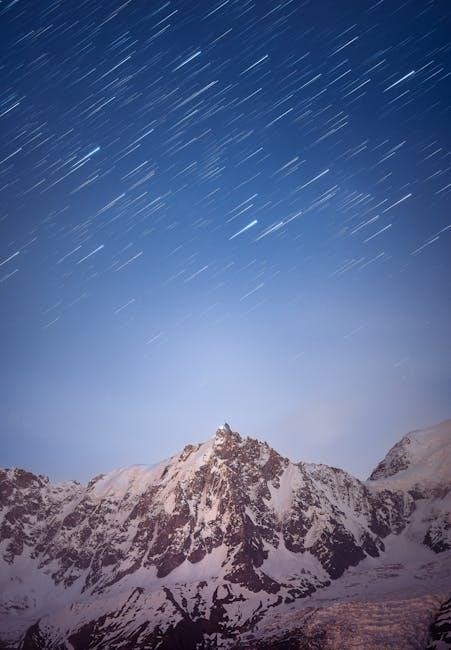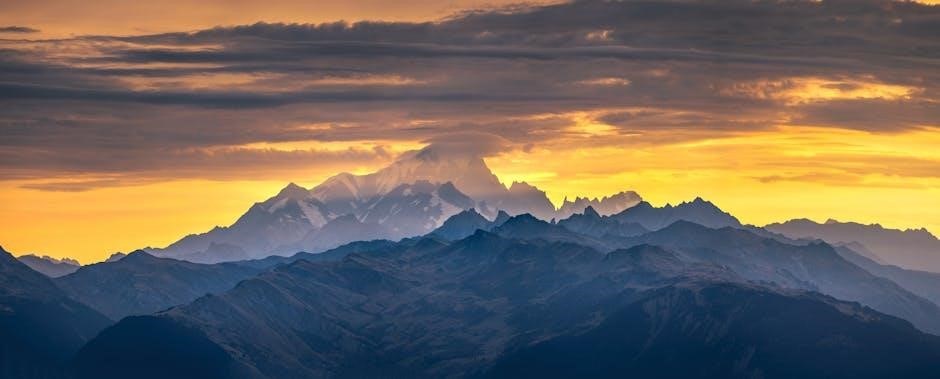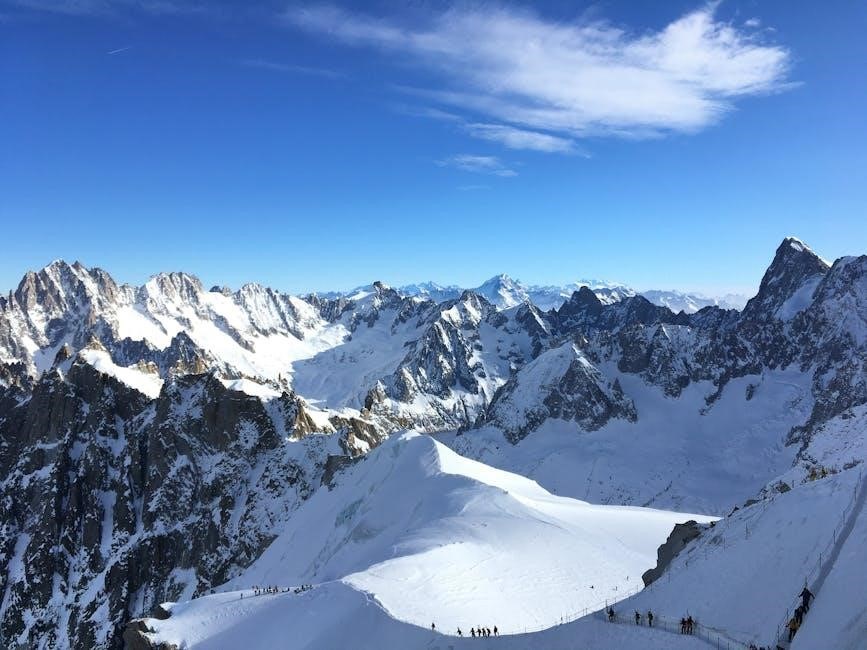The Tour du Mont Blanc is one of Europe’s most iconic long-distance hikes, circling Mont Blanc through France, Italy, and Switzerland. A self-guided tour offers hikers the freedom to explore stunning mountain landscapes, charming villages, and high-altitude trails at their own pace. Perfect for experienced hikers seeking independence, this journey provides a mix of challenging terrain and breathtaking views, culminating in a rewarding adventure around the highest peak in the Alps.
Overview of the Tour du Mont Blanc
The Tour du Mont Blanc (TMB) is a renowned long-distance hiking trail in Europe, circling the majestic Mont Blanc, the highest peak in the Alps. Spanning approximately 160 kilometers, the trail winds through France, Italy, and Switzerland, offering breathtaking mountain vistas, charming villages, and diverse landscapes. Typically completed in 7 to 12 days, the TMB is a challenging yet rewarding adventure. Hikers can choose from various itineraries, ranging from 7-day condensed routes to more leisurely 11-day journeys, allowing flexibility to suit different fitness levels and preferences.
Why Choose a Self-Guided Tour?
A self-guided Tour du Mont Blanc offers unparalleled freedom and flexibility, allowing hikers to explore at their own pace and immerse themselves in the stunning Alpine landscapes. By planning and booking accommodations independently, hikers can control costs and tailor the itinerary to their preferences, avoiding the constraints of group tours. This approach is ideal for experienced hikers who enjoy autonomy and are comfortable navigating with maps and GPS. It also provides opportunities to connect with local cultures and nature without the rush, making the journey a deeply personal and enriching experience.
Planning Your Itinerary
Planning your Tour du Mont Blanc itinerary involves deciding on the duration, choosing between clockwise or counterclockwise routes, and understanding the trail’s stages. Utilize detailed maps and GPS tools to create a personalized schedule that fits your hiking pace and preferences, ensuring a seamless and enjoyable journey through the Alpine landscapes.
Deciding on the Duration of Your Hike
The duration of your Tour du Mont Blanc hike varies from 7 to 12 days, depending on your fitness level and desired pace. A 10-day itinerary is most common, allowing hikers to complete the 160-kilometer loop without rushing. Shorter itineraries, like 7 or 8 days, are ideal for experienced hikers who want to move quickly, while longer durations provide a more relaxed experience. Consider your physical condition, the number of rest days, and how much time you wish to spend exploring the villages and landscapes along the way. Plan accordingly to ensure a memorable and enjoyable journey.
Choosing the Direction: Clockwise or Counterclockwise
Deciding the direction for your Tour du Mont Blanc hike is a key decision. The counterclockwise route is more popular, offering well-marked trails and stunning views of Mont Blanc. Clockwise hiking is less crowded but includes steeper ascents. Both directions cover the same distance and scenery but provide different experiences. Clockwise is recommended for those seeking solitude, while counterclockwise is ideal for traditional navigation. Consider your preferences and fitness level when choosing. Both directions promise breathtaking landscapes and unforgettable moments on this iconic trail.
Understanding the Stages of the Tour
The Tour du Mont Blanc is typically divided into 7 to 10 stages, each offering a unique blend of terrain and scenery. Stages vary in length, from 15 to 25 kilometers, and difficulty, with some days featuring steep ascents or descents. The trail winds through France, Italy, and Switzerland, providing diverse landscapes, from alpine meadows to rugged mountain passes. Each stage ends in a picturesque village or refuge, allowing hikers to rest and recharge. Understanding the breakdown of these stages helps in planning daily goals and appreciating the gradual unfolding of Mont Blanc’s majesty.

Accommodation Options
Along the Tour du Mont Blanc, hikers can stay in refuges, mountain huts, or small lodgings, offering basic to comfortable stays. Booking in advance is essential, especially for popular refuges.
Types of Accommodation Along the Route
The Tour du Mont Blanc offers diverse accommodation options, including mountain refuges, huts, and small lodgings. Refuges provide basic dormitory-style rooms with shared facilities, while some offer private rooms. Mountain huts are rustic and located in remote areas, ideal for immersive experiences. Additionally, villages along the route have charming hotels and guesthouses for more comfort. Booking in advance is crucial, especially during peak season, as refuges and lodgings fill up quickly. Local companies like Adventure Base and Macs Adventure assist with reservations, ensuring a smooth experience for self-guided hikers.
How to Book Refuges and Lodgings
Booking refuges and lodgings along the Tour du Mont Blanc requires early planning, especially during peak season. Many refuges can be reserved directly through their websites or local booking platforms. Companies like Adventure Base and Mont Blanc Treks offer comprehensive booking services, including lodging and luggage transfers. Some hikers prefer using guidebooks like the Cicerone for refuge contacts. Advance reservations are essential, as popular refuges fill quickly. Additionally, local tour operators provide support for self-guided hikers, ensuring seamless accommodations throughout the journey.

Essential Information for Hikers
Navigating the Tour du Mont Blanc requires maps, GPS, and trail markers. Always carry emergency supplies and know local regulations. Respect the environment to preserve its beauty.
Navigating the Trail: Maps, Markers, and GPS
Navigating the Tour du Mont Blanc requires reliable tools. Carry detailed maps, such as those from the Cicerone guidebook, and use trail markers like painted signs and stone cairns. GPS apps like Komoot or Gaia GPS are essential for real-time tracking. Ensure your devices are fully charged, and consider carrying a backup power source. The trail is well-marked, but occasional white-and-red markers and signposts guide hikers. Understanding the trail layout and stages beforehand enhances navigation. Plan to hike 7-12 days, covering approximately 160km, and use GPS to stay on track, especially in less obvious sections.
Safety Tips and Emergency Procedures
Ensure safety on the Tour du Mont Blanc by carrying emergency supplies like a first aid kit, headlamp, and whistle. Always inform someone of your itinerary and check weather forecasts to avoid storms. Stay on marked trails to prevent injuries and environmental damage. Carry a portable phone charger and know emergency numbers like 112. In case of an emergency, use GPS to locate your position and contact authorities. Be prepared for altitude changes and varying weather conditions. Self-guided hikers should assess their fitness level and plan accordingly to maintain a safe pace throughout the journey.
Physical Preparation and Gear
Build stamina and strength for the demanding terrain. Pack lightweight, durable gear, including hiking boots, layers, and a waterproof jacket for unpredictable mountain weather conditions.
Training and Fitness Requirements
The Tour du Mont Blanc requires a high level of physical fitness due to its demanding terrain and elevation changes. Hikers should engage in regular cardio and strength training for several months prior to the trip. Building endurance through long-distance walks with a loaded backpack is essential. Incorporate hill climbs and stair exercises to prepare for the ascent and descent sections; Aim for at least 6-8 hours of hiking per day during training to simulate the tour’s demands. Proper acclimatization to high altitudes and variable weather conditions is also crucial for a successful and safe experience.
Packing Essentials for the Tour
Packing smartly is crucial for the Tour du Mont Blanc. Bring sturdy hiking boots, waterproof clothing, and layered breathable apparel for varying weather. Include a lightweight backpack, trekking poles, and a first-aid kit. Navigation tools like maps and a GPS device are indispensable. Don’t forget a reusable water bottle, snacks, and personal hygiene items. Accommodation essentials include a sleeping bag liner for refuges and earplugs for shared rooms. Pack a headlamp for early starts or late arrivals, and ensure your gear is lightweight to manage the daily 15-20 km hikes comfortably. Always check the weather forecast to adjust your kit accordingly.
Budgeting and Cost Management
The Tour du Mont Blanc requires careful budgeting, with accommodation costs varying by season. Early booking and public transport can reduce expenses. Plan meals and gear wisely.
Estimating Costs for the Trip
Estimating costs for the Tour du Mont Blanc involves considering accommodation, meals, transportation, and gear. Average daily costs range from €60 to €100, depending on choices. Accommodation in refuges or hotels can vary from €20 to €50 per night. Meals in mountain huts range from €10 to €15 for dinner. Transportation costs, such as bus or train passes, can add €20 to €50. Gear and equipment expenses should be considered if you need to purchase or rent items. Budgeting in advance helps manage expenses effectively for a smooth and enjoyable self-guided tour.
Ways to Save Money on the Tour
Planning ahead is key to saving money on the Tour du Mont Blanc. Consider staying in dormitories or budget-friendly refuges to reduce accommodation costs. Opt for self-catering options to prepare meals instead of dining out. Avoid single supplements by booking shared rooms or traveling with a partner. Use public transport passes for cost-effective travel between stages. Pack light to avoid extra baggage fees and bring reusable water bottles to refill at mountain fountains. Lastly, take advantage of early booking discounts and free resources for navigation to minimize expenses while enjoying the hike.

Tips for a Successful Self-Guided Tour
Thorough planning, flexibility, and self-reliance are essential for a successful self-guided Tour du Mont Blanc. Use GPS and maps for navigation, book refuges early, and pack essentials wisely.
Using Public Transport on the Route
Public transport is a convenient option for self-guided hikers on the Tour du Mont Blanc, allowing flexibility and efficiency. Buses and trains connect key villages and trailheads, enabling hikers to skip less interesting sections or reduce walking time. For example, using public transport can help bypass challenging stages like stage 7 or 10, as mentioned in some itineraries. This option is particularly useful for hikers who want to focus on the most scenic parts of the trail or need to adapt their itinerary due to fatigue or weather conditions.
Additionally, public transport can be used to transfer luggage or connect start and end points, ensuring a smoother journey. Hikers should plan ahead by researching local bus and train schedules to optimize their route effectively.
Respecting the Environment and Local Regulations
Respecting the environment and local regulations is essential when hiking the Tour du Mont Blanc. The trail passes through sensitive alpine ecosystems, so hikers should minimize their impact by carrying out all waste and avoiding off-trail deviations; Staying on marked paths helps protect fragile habitats and prevent erosion. Additionally, hikers must adhere to local rules, such as restrictions on wild camping or campfires, to preserve the natural beauty of the region. By being mindful of these practices, hikers contribute to the long-term sustainability of this iconic trail for future generations to enjoy.

Final Checks Before Departure
Confirm all bookings, check the weather forecast, pack essential gear, and ensure travel documents are ready. Double-check transportation and accommodation details before starting your Tour du Mont Blanc adventure.
Confirming Bookings and Itinerary Details
Before departing, meticulously review all accommodation bookings, ensuring each refuge or lodge is confirmed and matches your itinerary. Verify the dates, locations, and meal arrangements, especially since some refuges may have specific check-in times or meal schedules. Double-check your transportation links, such as bus or train connections, to ensure smooth transitions between stages. Additionally, confirm any luggage transfer services if arranged, and make sure your itinerary aligns with local operating hours and seasonal availability. A detailed, accurate plan prevents unexpected disruptions and ensures a seamless hiking experience on the Tour du Mont Blanc.
Weather Forecast and Last-Minute Preparations
Always check the latest weather forecast before your departure, as mountain conditions can change rapidly. Ensure you have appropriate clothing for varying weather, including rain gear and warm layers. Verify that your hiking poles, footwear, and backpack are in good condition. Charge all electronic devices, and pack essential items like a first-aid kit, map, and headlamp. Double-check the trail’s current condition and any potential closures. Finally, confirm your itinerary and accommodation details one last time to avoid any last-minute issues. Being well-prepared ensures a smooth and enjoyable start to your Tour du Mont Blanc adventure.
